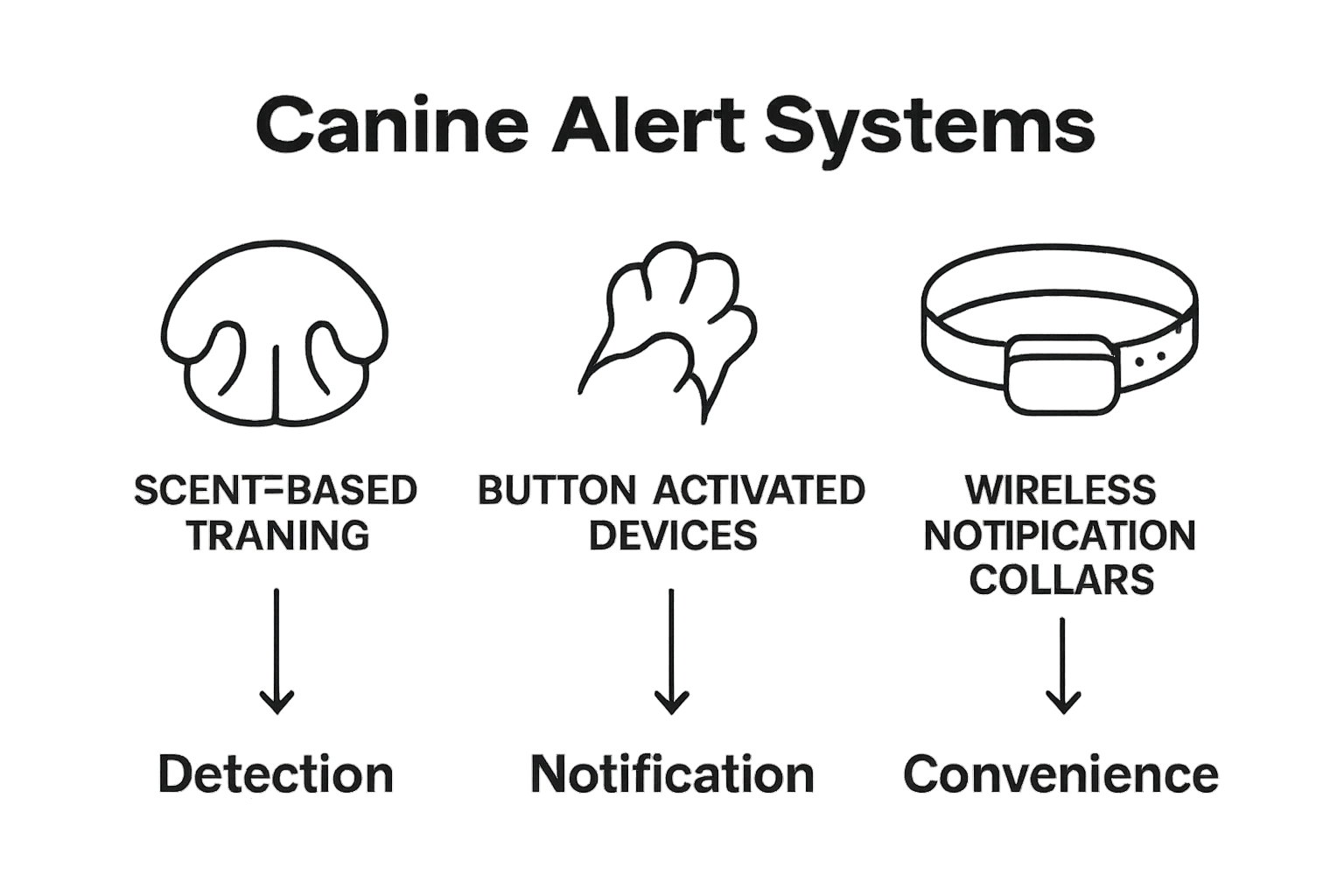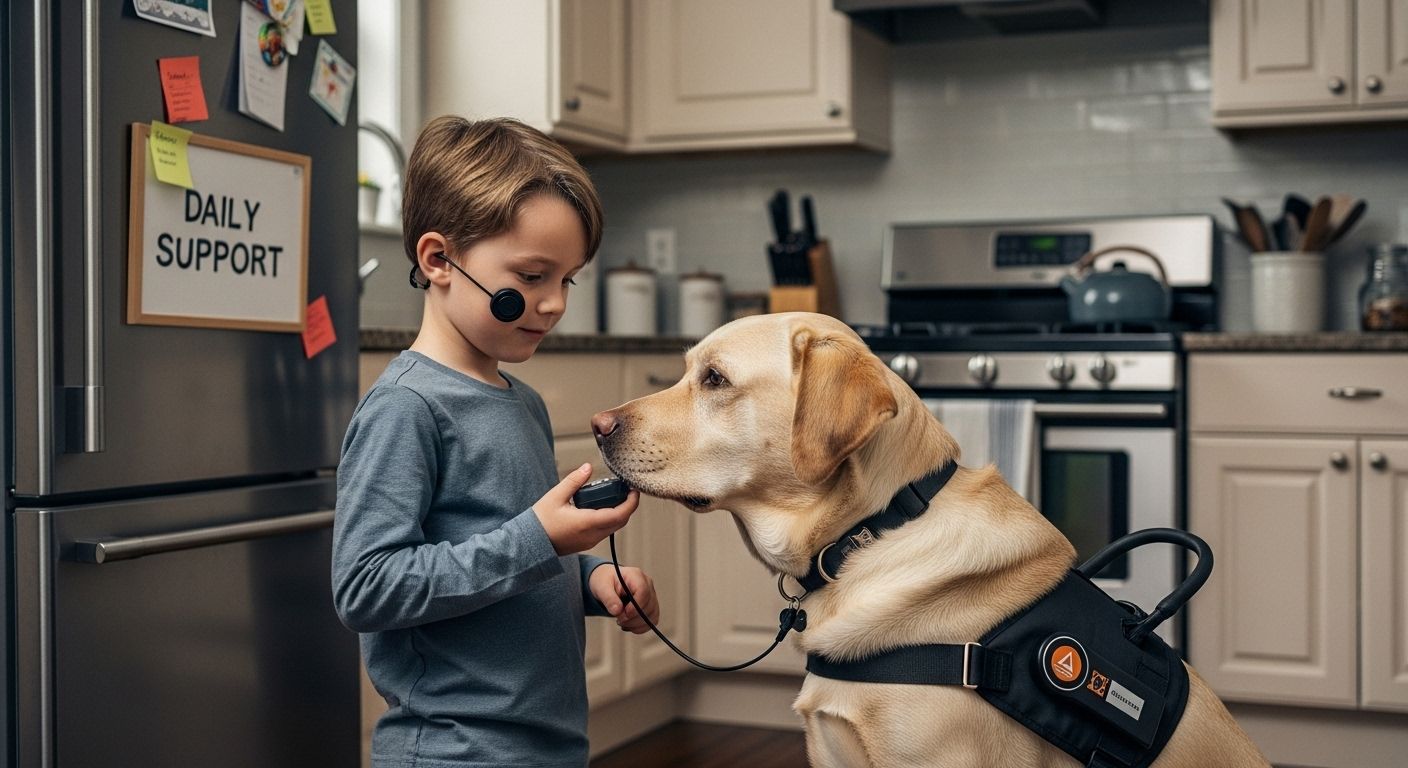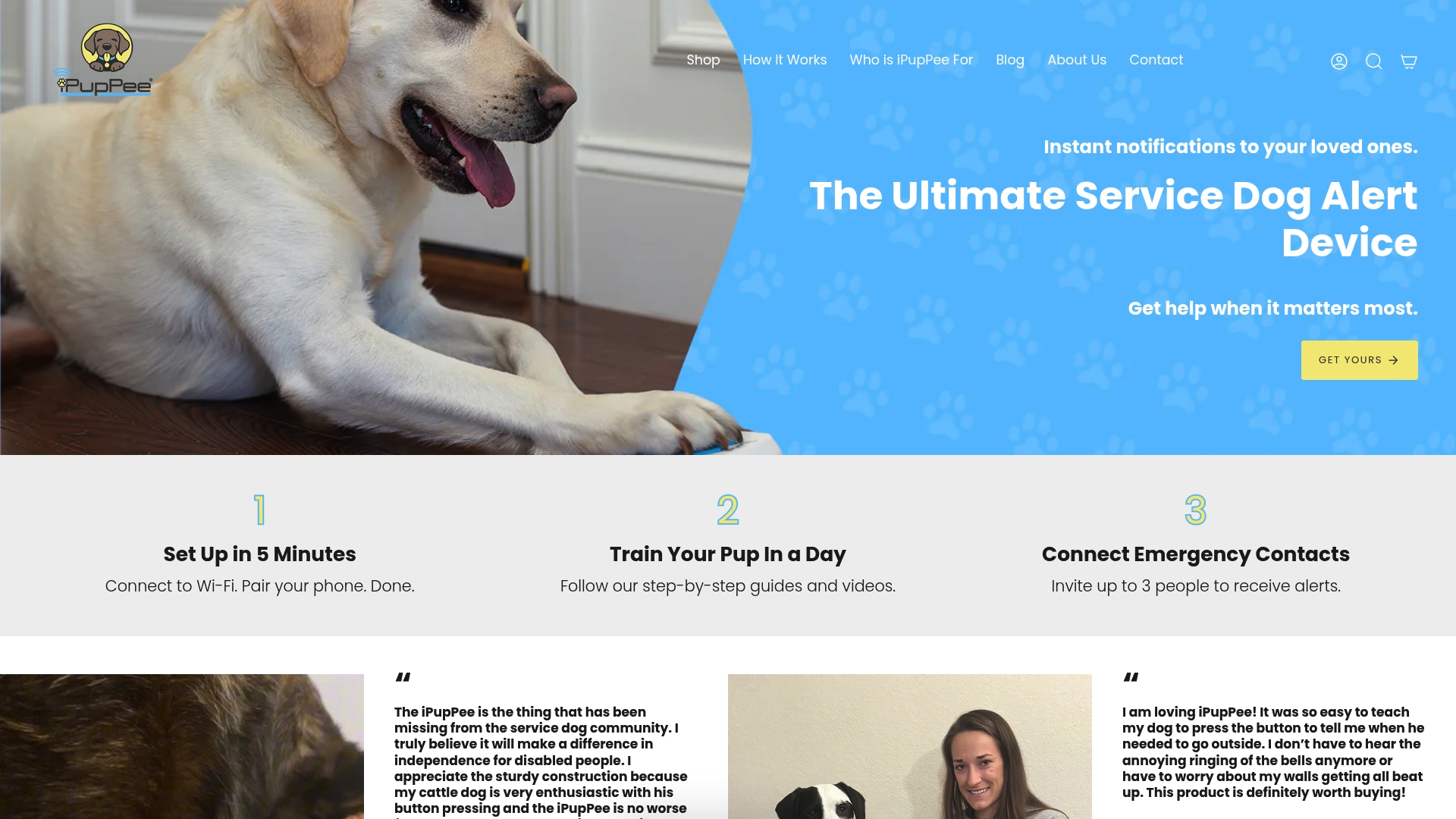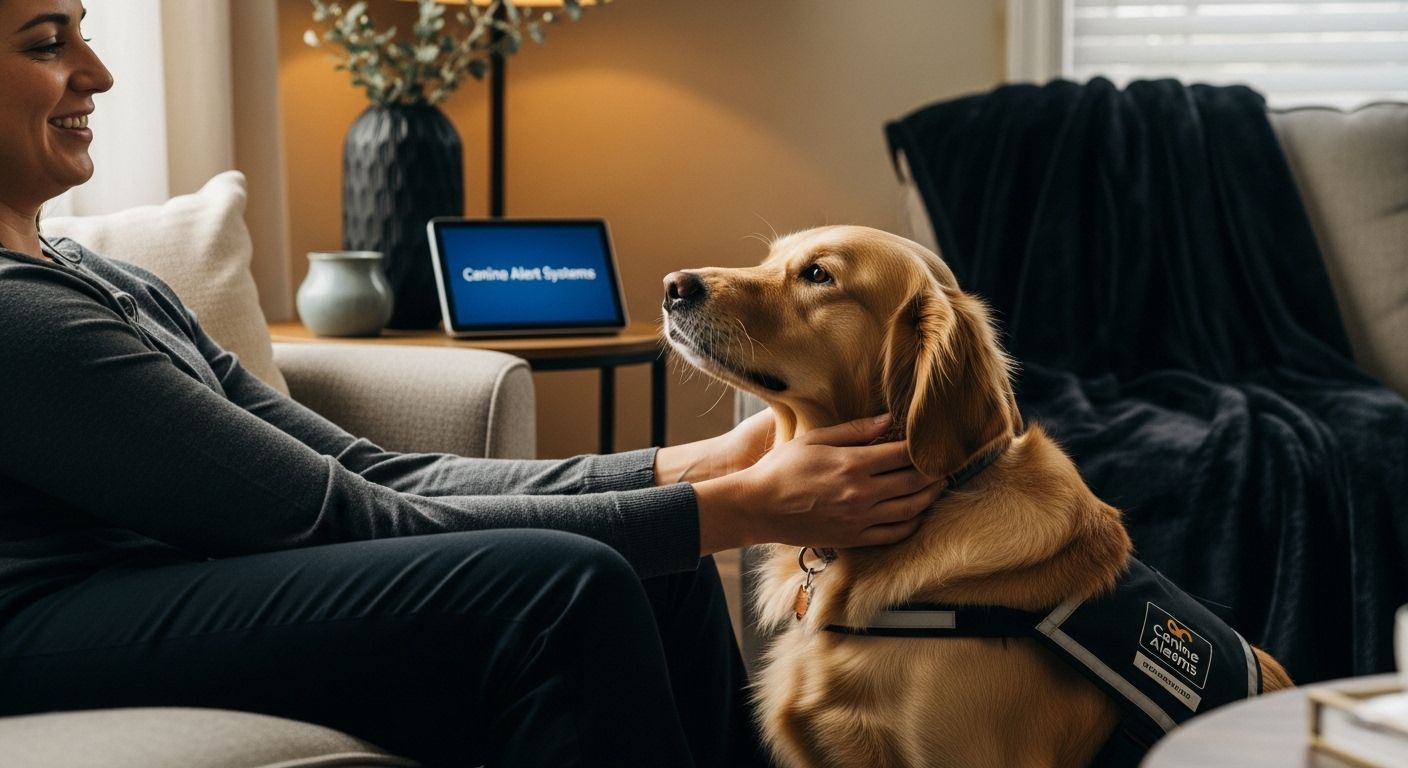Canine alert systems are changing how people with health challenges connect with their dogs. These are not just gadgets and gimmicks. Some trained dogs have been shown to detect seizures minutes before they happen, providing life-saving alerts. Most people think technology alone keeps us safe, but it turns out the real magic comes from the unique bond and instinctive communication shared between humans and their dogs.
Table of Contents
- What Are Canine Alert Systems And Their Purpose?
- The Importance Of Canine Alert Systems In Daily Life
- How Canine Alert Systems Function: A Deeper Look
- Key Components Of Effective Canine Alert Systems
- Real-World Applications And Success Stories
Quick Summary
| Takeaway | Explanation |
|---|---|
| Canine alert systems enhance human-dog communication. | These systems enable dogs to effectively signal critical health events to their handlers, improving safety. |
| Technology and training work together for effectiveness. | Successful systems combine advanced technology with specialized training, allowing dogs to detect and communicate health risks. |
| Alert systems empower independence for users. | Individuals with disabilities gain confidence and autonomy, reducing reliance on human caregivers through the use of these systems. |
| They provide psychological and emotional benefits. | Beyond practical uses, these systems foster security and strengthen the bond between dogs and their handlers. |
| Wide application across various medical scenarios. | Canine alert systems can monitor conditions like diabetes and epilepsy, showcasing their versatility in health management. |
What are Canine Alert Systems and Their Purpose?
Canine alert systems represent sophisticated communication technologies designed to bridge the gap between dogs and their human companions, particularly for individuals with specific medical conditions or specialized needs. These innovative systems enable dogs to communicate critical information quickly and effectively, transforming how people with disabilities or health challenges interact with their service and companion animals.
Understanding the Core Purpose
The fundamental purpose of canine alert systems is to provide a reliable method for dogs to signal important events or potential health risks to their handlers. Research from medical studies demonstrates that these systems can be particularly crucial for individuals managing conditions like epilepsy, where early warning can mean the difference between a controlled response and a medical emergency.
Key Components and Functionality
Canine alert systems typically involve specialized devices or training methods that allow dogs to communicate through:
- Pressing a dedicated communication button
- Triggering wireless alerts to caregivers
- Transmitting specific signals about potential health events
- Providing immediate notification mechanisms
These systems are not just technological solutions but represent a profound understanding of the deep communication potential between humans and dogs. By creating structured communication pathways, canine alert systems empower dogs to actively participate in their handler’s safety and well-being.
Below is a table organizing the key components and functionality of canine alert systems to clarify their structure and operation.
| Component | Description |
|---|---|
| Communication Button | Device that allows dogs to signal alerts by pressing a button |
| Wireless Alerts | Sends notifications to caregivers or devices wirelessly when the dog triggers an alert |
| Specific Signal Transmission | Enables dogs to transmit distinct signals relevant to particular health risks |
| Immediate Notification Mechanisms | Provides real-time alerts to handlers about potential emergencies |
| Specialized Training | Teaches dogs to recognize and act upon physiological or environmental signals |

For those interested in exploring more about these remarkable communication tools, discover our comprehensive guide on modern dog alert options. Understanding how these systems work can significantly enhance the relationship between dogs and their human companions, offering newfound independence and security for individuals with specialized needs.
The Importance of Canine Alert Systems in Daily Life
Canine alert systems are transformative technologies that go far beyond simple communication mechanisms, offering critical lifeline support for individuals facing diverse medical and personal challenges. These systems represent more than technological innovation. They embody a profound partnership between humans and dogs that can fundamentally improve quality of life, safety, and independence.
Expanding Personal Independence
Research from medical studies indicates that service dogs and their alert systems provide substantial benefits that extend well beyond immediate medical support. These systems empower individuals with disabilities to navigate daily life with increased confidence and reduced dependency on human caregivers.
Critical Support Across Different Scenarios
Canine alert systems demonstrate remarkable versatility in supporting individuals with various needs:
- Medical condition monitoring (diabetes, epilepsy)
- Mobility assistance for individuals with physical disabilities
- Emotional support for individuals with mental health challenges
- Early warning systems for potential health emergencies
The profound impact of these systems lies not just in their technological capabilities, but in their ability to restore agency and dignity to individuals who might otherwise feel constrained by their medical conditions.
This table highlights some major medical and daily life applications of canine alert systems, providing a quick reference for their diverse uses.
| Application Area | Example Conditions / Uses |
|---|---|
| Medical Monitoring | Diabetes (blood sugar alerts), epilepsy (seizure detection) |
| Mobility Assistance | Support for individuals with physical disabilities |
| Emotional Support | Anxiety, mental health challenges |
| Early Emergency Warning | Cardiac issues, other health emergencies |
Psychological and Emotional Benefits
Beyond practical functionality, canine alert systems offer significant psychological advantages. They create a sense of security, reduce anxiety, and foster a deeper bond between dogs and their handlers. Learn more about advanced alert system options that can revolutionize how individuals with specialized needs interact with their canine companions.
Ultimately, these systems are not just about technology. They represent a testament to the incredible communication potential between humans and dogs, showcasing how understanding and innovation can create profound improvements in people’s lives.
How Canine Alert Systems Function: A Deeper Look
Canine alert systems represent a sophisticated intersection of animal intuition, specialized training, and cutting-edge technology. These systems leverage dogs’ extraordinary sensory capabilities and cognitive intelligence to create seamless communication pathways between animals and their human companions.
Sensory Detection Mechanisms
Research from veterinary science reveals that dogs possess remarkable abilities to detect minute physiological changes through advanced olfactory and sensory perception. Their keen sense of smell allows them to recognize subtle biochemical shifts associated with medical conditions, enabling them to provide early warning signals for potential health emergencies.
Core Functional Components
Canine alert systems typically incorporate multiple sophisticated detection and communication strategies:
- Advanced scent recognition techniques
- Specialized training protocols
- Wireless communication technologies
- Personalized alert mechanisms
These components work synergistically to transform a dog’s natural observational skills into a structured, reliable communication system. By combining innate animal instincts with technological innovations, alert systems create unprecedented support mechanisms for individuals with diverse medical and personal needs.
Training and Technological Integration
Successful canine alert systems require comprehensive training that goes beyond traditional service dog preparation. Dogs must learn to:
- Recognize specific physiological signals
- Communicate alerts consistently
- Remain calm during potential medical events
- Understand precise notification protocols
Explore our comprehensive guide to advanced alert system technologies to understand how these intricate systems transform canine capabilities into lifesaving communication tools. The future of human-animal interaction lies in these intelligent, empathetic technological partnerships that bridge communication gaps and provide unprecedented levels of support and independence.
Key Components of Effective Canine Alert Systems
Effective canine alert systems are complex ecosystems of training, technology, and mutual understanding between dogs and their handlers. These systems require precise coordination of multiple elements to ensure reliable, consistent, and meaningful communication that can potentially save lives or significantly improve quality of life.
Training and Behavioral Foundations
Research from veterinary behavioral studies highlights that successful alert systems fundamentally depend on sophisticated social reinforcement techniques. Dogs must be trained not just to recognize specific physiological signals, but to communicate those signals consistently and appropriately through predetermined alert mechanisms.
Essential Technical Components
Canine alert systems incorporate several critical technical and behavioral elements:
- Precise signal recognition protocols
- Customized communication interfaces
- Robust wireless notification technologies
- Adaptive learning mechanisms
- Stress management and emotional regulation training
These components work together to transform a dog’s natural observational capabilities into a structured, reliable communication system. The goal is not simply to detect changes, but to create a seamless, intuitive interaction that feels natural to both the dog and the handler.
Holistic Welfare and Performance Considerations
The effectiveness of canine alert systems extends beyond technical training. Discover comprehensive insights into alert dog training techniques that emphasize the critical importance of the dog’s overall well-being. Successful systems recognize that a dog’s physical health, emotional state, and environmental conditions are just as crucial as their technical training.
Ultimately, the most effective canine alert systems are those that respect and enhance the profound bond between dogs and humans, creating communication pathways that are both technologically sophisticated and deeply empathetic.
Real-World Applications and Success Stories
Canine alert systems represent far more than theoretical technology. They are powerful, life-changing interventions that transform the daily experiences of individuals facing complex medical and personal challenges, offering unprecedented levels of support and independence.
Medical Emergency Detection
Research from medical studies reveals remarkable success in canine alert systems, particularly in diabetes and seizure management. Trained dogs can detect minute physiological changes that signal potential medical emergencies, providing critical early warnings that can prevent serious health complications or even save lives.
Diverse Practical Applications
Canine alert systems demonstrate extraordinary versatility across multiple domains:
- Diabetes blood sugar level monitoring
- Seizure prediction and intervention
- Cardiac event detection
- Mental health support and anxiety management
- Mobility assistance for individuals with physical disabilities
These applications showcase how sophisticated training and technological integration can amplify a dog’s natural sensory capabilities into precise, life-sustaining communication mechanisms. Each successful intervention represents a profound testament to the deep communication potential between humans and their canine companions.
Transformative Personal Narratives
Beyond technical specifications, the true power of canine alert systems lies in their human stories. Explore more about real-world alert system success strategies to understand how these remarkable systems restore dignity, independence, and hope to individuals facing significant personal challenges.
Each alert system is more than a technological solution. It is a bridge of understanding, a lifeline of support, and a powerful demonstration of the extraordinary bond between humans and dogs.

Ready for Clearer Communication and Greater Independence with Your Dog?
Struggling with the uncertainty that comes from not knowing if your dog can alert you in an emergency? The article highlights how many people feel anxious about missing important signals from their dogs, especially those managing medical conditions, living alone, or seeking more independence. Canine alert systems bridge this critical gap, but reliable solutions can seem hard to find. Imagine a day when your companion can press a simple button to alert you or others, offering both safety and peace of mind.

Experience how the iPupPee alert device and our step-by-step training resources turn advanced canine communication into an everyday reality. Discover stories from real pet owners who regained confidence thanks to iPupPee’s unique design. Visit https://ipuppee.com today to see product features, testimonials, and support resources. Take control of your safety and your dog’s ability to help—start building your own communication system now.
Frequently Asked Questions
What are canine alert systems?
Canine alert systems are specialized communication technologies that enable dogs to signal important health information or potential medical emergencies to their handlers, particularly benefiting individuals with specific medical conditions.
How do canine alert systems improve personal independence?
These systems empower individuals with disabilities by allowing them to interact more confidently and independently, reducing their reliance on human caregivers through effective monitoring and alerting capabilities.
What types of medical conditions can canine alert systems assist with?
Canine alert systems can be beneficial for various conditions, including diabetes, epilepsy, cardiac issues, and mental health challenges by providing early warning signals for potential health emergencies.
How do training and technology integrate in canine alert systems?
Training for canine alert systems involves teaching dogs to recognize specific physiological signals and use predefined communication methods, while technology enhances these capabilities through tools like wireless alerts and customized interfaces.

